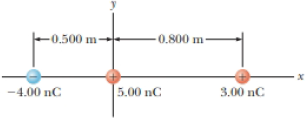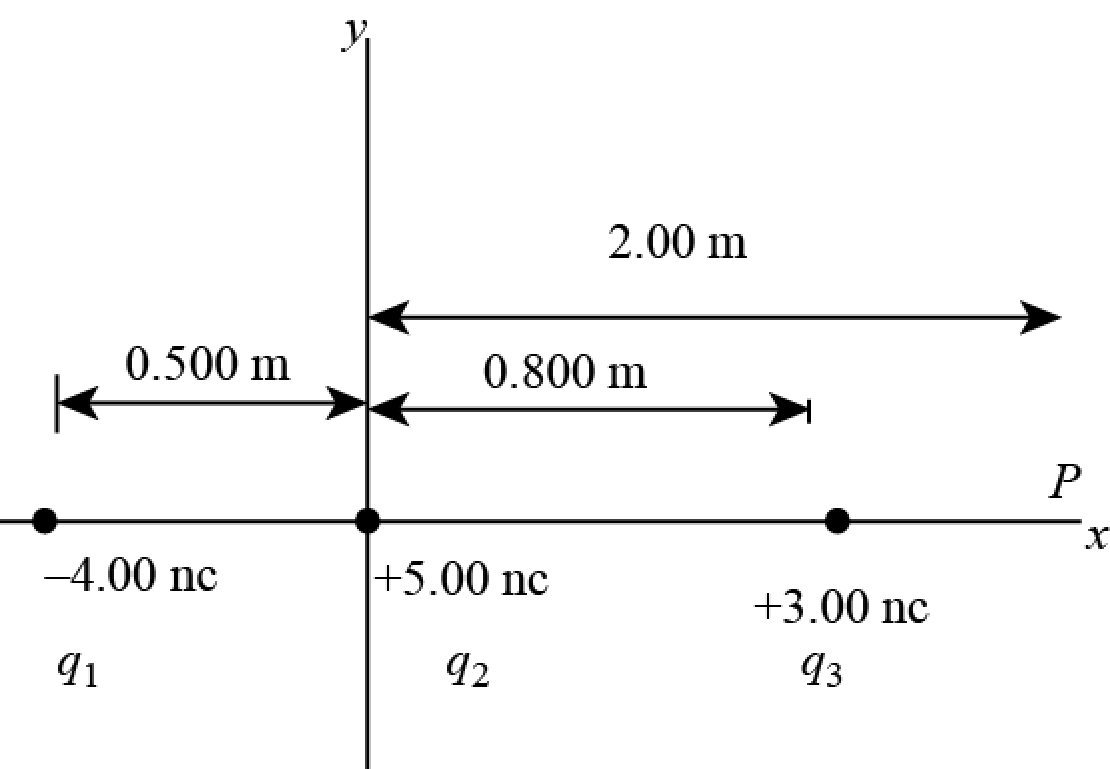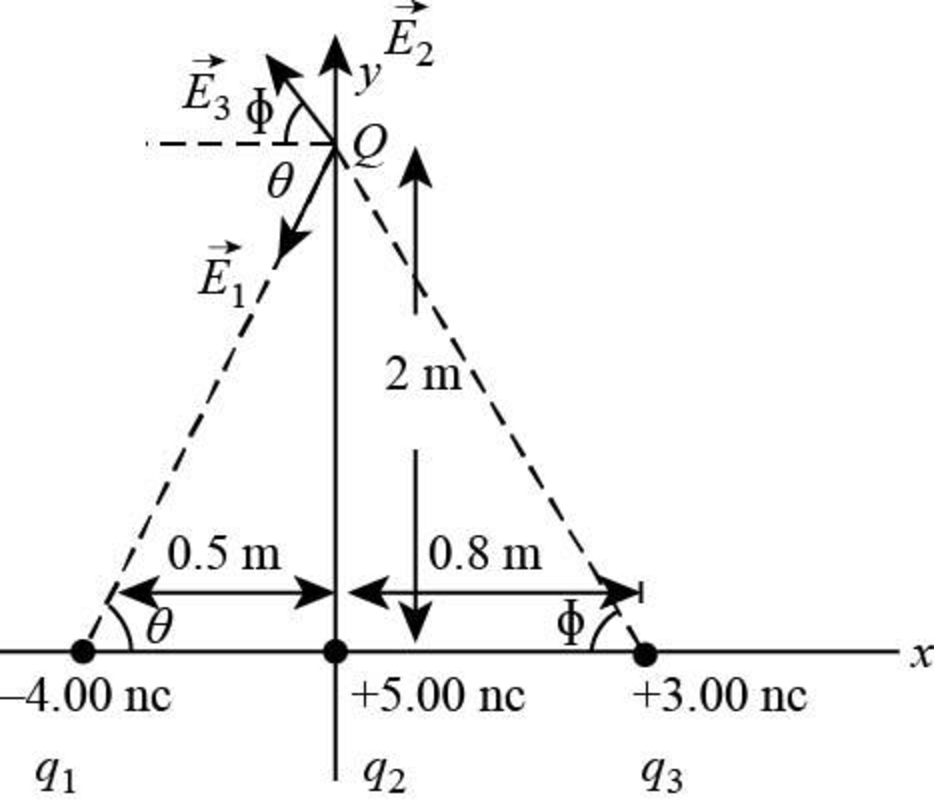
Concept explainers
Three charged particles are aligned along the x axis as shown in Figure P22.35. Find the electric field at (a) the position (2.00 m, 0) and (b) the position (0, 2.00 m).
Figure P22.35

(a)
The electric field at the position
Answer to Problem 23.69AP
The electric field at the position
Explanation of Solution
Three charges are acting on the same line along the
According to Coulomb’s law, write the expression for the electric field created by a charge
Here,
The electric field at a point due to number of charges is resultant of the electric field due to the individual charges.
The figure for the position of point charges is shown below.

Figure (1)
Write the expression for the electric field due to charge
Here,
Substitute
Write the expression for the electric field due to charge
Here,
Substitute
Write the expression for the electric field due to charge
Here,
Substitute
Write the expression for the resultant electric field
Here,
Conclusion:
Substitute
Thus, the electric field at position
(b)
The electric field at the position
Answer to Problem 23.69AP
The electric field at the position
Explanation of Solution
Three charges are acting on the same line along the
The figure for the position of point charges is shown below,

Figure (2)
According to Pythagoras theorem, the distance between the charge
Here,
According to Pythagoras theorem, the distance between the charge
Here,
Write the expression for the electric field due to charge
Here,
Substitute
In component form the electric field can be written as,
According to right angle triangle property,
And,
Substitute
Write the expression for the electric field due to charge
Here,
Substitute
Write the expression for the electric field due to charge
Here,
Substitute
In component form the electric field can be written as,
According to right angle triangle property,
And,
Substitute
Write the expression for the resultant electric field
Here,
Conclusion:
Substitute
Therefore, the electric field at position
Want to see more full solutions like this?
Chapter 23 Solutions
Physics for Scientists and Engineers, Technology Update (No access codes included)
- 13. After a gust of wind, an orb weaver spider with a mass of 35 g, hanging on a strand of web of length L = .420 m, undergoes simple harmonic motion (SHO) with an amplitude A and period T. If the spider climbs 12.0 cm up the web without perturbing the oscillation otherwise, what is the period of oscillation, in Hz to three significant figures?arrow_forward15. An object of mass m = 8.10 kg is attached to an ideal spring and allowed to hang in the earth's gravitational field. The spring stretches 23.10 cm before it reaches its equilibrium position. The mass then undergoes simple harmonic motion with an amplitude of 10.5 cm. Calculate the velocity of the mass in m/s at a time t= 1.00s to three significant figures.arrow_forwardplease solve and answer the question correctly. Thank you!!arrow_forward
- 18arrow_forward1. Some 1800 years ago Roman soldiers effectively used slings as deadly weapons. The length of these slings averaged about 81 cm and the lead shot that they used weighed about 30 grams. If in the wind up to a release, the shot rotated around the Roman slinger with a period of .14 seconds. Find the maximum acceleration of the shot before being released in m/s^2 and report it to two significant figures.arrow_forward16arrow_forward
- 11. A small charged plastic ball is vertically above another charged small ball in a frictionless test tube as shown in the figure. The balls are in equilibrium at a distance d= 2.0 cm apart. If the charge on one ball is tripled, find the new equilibrium distance between the balls in cm and report it to the proper number of significant figures.arrow_forward12. The electric field at a point 1.3 cm from a small object points toward the object with a strength of 180,000 N/C. Find the object's charge q, in nC to the proper number of significant figures. k = 1/4πε0 = 8.99 × 10^9 N ∙ m^2/C^2arrow_forward14. When the potential difference between the plates of an ideal air-filled parallel plate capacitor is 35 V, the electric field between the plates has a strength of 670 V/m. If the plate area is 4.0 × 10^-2 m^2, what is the capacitance of this capacitor in pF? (ε0 = 8.85 × 10^-12 C^2/N ∙ m^2)arrow_forward
- 10. A small styrofoam ball of mass 0.500 g is placed in an electric field of 1140 N/C pointing downward. What excess charge must be placed on the ball for it to remain suspended in the field? Report your answer in micro-Coulombs to three significant figures.arrow_forward2arrow_forwardplease solve and answer the question correctly. Thank you!!arrow_forward
 Physics for Scientists and EngineersPhysicsISBN:9781337553278Author:Raymond A. Serway, John W. JewettPublisher:Cengage Learning
Physics for Scientists and EngineersPhysicsISBN:9781337553278Author:Raymond A. Serway, John W. JewettPublisher:Cengage Learning Physics for Scientists and Engineers with Modern ...PhysicsISBN:9781337553292Author:Raymond A. Serway, John W. JewettPublisher:Cengage Learning
Physics for Scientists and Engineers with Modern ...PhysicsISBN:9781337553292Author:Raymond A. Serway, John W. JewettPublisher:Cengage Learning Physics for Scientists and Engineers: Foundations...PhysicsISBN:9781133939146Author:Katz, Debora M.Publisher:Cengage Learning
Physics for Scientists and Engineers: Foundations...PhysicsISBN:9781133939146Author:Katz, Debora M.Publisher:Cengage Learning Principles of Physics: A Calculus-Based TextPhysicsISBN:9781133104261Author:Raymond A. Serway, John W. JewettPublisher:Cengage Learning
Principles of Physics: A Calculus-Based TextPhysicsISBN:9781133104261Author:Raymond A. Serway, John W. JewettPublisher:Cengage Learning College PhysicsPhysicsISBN:9781285737027Author:Raymond A. Serway, Chris VuillePublisher:Cengage Learning
College PhysicsPhysicsISBN:9781285737027Author:Raymond A. Serway, Chris VuillePublisher:Cengage Learning College PhysicsPhysicsISBN:9781305952300Author:Raymond A. Serway, Chris VuillePublisher:Cengage Learning
College PhysicsPhysicsISBN:9781305952300Author:Raymond A. Serway, Chris VuillePublisher:Cengage Learning





